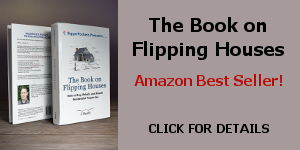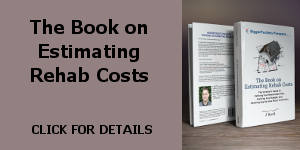
I haven’t been great about keeping up with all our rental properties, but I promised that I would continue providing a long-term analysis of our first rental (at least annually), so that others looking to get into the rental business can get an idea of what to expect. As a reminder, here is a link to a detailed overview of that property (Click Here), including pictures, detailed purchase analysis, rehab analysis, and all anticipated financial details. And here is a link to our 1-Year Update on the property (Click Here).
We’re still about three weeks away from the two year anniversary of putting that rental on the market, but the rent and all expenses have been paid through that anniversary date, and I don’t expect any surprises in the next three weeks. So, instead of waiting a couple weeks to put together the 2-Year Update, I thought I’d just knock it out a little bit early.
Before I jump into the financials, here’s the basic recap of the year:
- After their one year lease was up last February, our first tenants decided to go month-to-month at $1500/month (instead of $1450/month), as they were planning to look for a place to buy. They gave their 60 day notice in July and moved out at the end of September.
- The property was very messy while the original tenants were still in the property, so we waited until move out to start marketing. We offered a half-month free rent as an incentive, and got a new renter in the property about two weeks after the first tenants moved out — a one year lease at $1450/month. With a half month of the property vacant and a half month of free rent to the new tenant, we lost about a month’s rent during the turnover.
- We spent a little over $1000 in maintenance for the year (including turnover costs), plus another $200 for cleaning between tenants.
- Turns out we had the wrong type of insurance on the property (landlord insurance instead of condo insurance), so we were able to bring our insurance costs down from nearly $500/year to under $200/year.
- Our property management company has continued to do a good job, with just a few minor hiccups here and there.
- Overall, probably spent about 5 hours this past year dealing with the property — notices from the HOA, questions from the management company, filling out forms, and one trip to the property to pull some weeds because we couldn’t get in touch with our landscaper and the HOA threatened to fine us.
Here is what our Profit and Loss Statement (P&L) looks like for the first year:

A few financial notes before I jump into the financial metrics:
- This represents 7 months of income at $1500/month (when the old tenants were month-to-month), and about 4 months of income at $1450/month (new tenants)
- There is no CapEx in this report, as CapEx doesn’t show up on a P&L – and because we didn’t have any CapEx last year. That said, most CapEx (roof, exterior, etc) is covered by the HOA, so that number will be proportionately lower long-term (though there’s a monthly HOA cost in our expenses).
- Property management fees include an entire first month tenant placement fee ($1450) – we only have two years of data, but so far, the average tenant stays 1.5 years, so we’re paying about $1000/year in placement fees. That’s a good bit, but it’s nice to not have to worry about finding tenants ourselves.
Our Net Income was $8338 – on a total cash investment of $79,374, that represents a cash-on-cash return of about 10.5%.
As I mentioned last year, my goal is typically about 12% cash-on-cash return, but this number will fluctuate over the years, and this is certainly within my acceptable range. If we were to leverage the property (take a loan on it), we could likely get that number closer to 15%, but we’re comfortable with having it paid off and making 10% these days.
Our total expense ratio (including rent loss and CapEx) for the year is about 46.16%, if you assume market rent at $1450/month.
While this number will fluctuate over the years with changes in CapEx, vacancy, additional turn-over costs, amortized tenant-placement costs, etc., for the second year in a row it falls squarely in line with the “50% Rule.” It’s actually lower than 50%, which is good, given that maintenance and capex tend to rise as the property ages. So, I’m comfortable saying that the 50% Rule most certainly applies to this property.
In the coming year, the HOA dues have increased from $165/month to $172/month — nothing significant. And there are no other major changes that we can currently forecast. That said, this business is full of surprises, so we’ll see what Year 3 has in store for us…




Great read! Keep up the awesome blog posts, they are very informative.
A home that rents for $1450 would cost you a minimum of $180,000 in my market, Austin, TX. You’d be *lucky* to get this for $180k.
Hey Dave –
Every market is different. In my area (where my personal residence is), I couldn’t find a house that’s move-in-ready for less than $300,000, period. And rentals make absolutely no sense in my area. Which is why I had to expand my search area. This rental property is about 40 minutes from where I live, and I own several properties in this same neighborhood with about the same numbers. It’s amazing the different 40 minutes can make. If I were to drive another 30 minutes further, I’d probably find even better deals!
That said, you may not be able to find any good rentals anywhere within driving distance of you — if that’s the case, rentals isn’t a good strategy in your area, and you should pursue another niche.
Thanks for sharing, what is CapEX means? also, it is a good idea to take a loan to invest for rentals instead of paying off for the property? you say “If we were to leverage the property (take a loan on it), we could likely get that number closer to 15%” how so? by the way, I live in Loudoun County, VA but willing to drive up to 50 minutes for investments.
Pilar:
Read these:
https://www.biggerpockets.com/renewsblog/2010/06/30/introduction-to-real-estate-analysis-investing/
http://www.123flip.com/all-about-leverage/
Hi J, are you finding flips still profitable in 2016/17 and do you have a new updated business model? I’m wanting to start a business and debating whether it should be based around real estate (notes,flips, or specs) or buying a non-related business from a retiring babyboomer. I have some other questions too. Do you respond to emails or have time to answer? Great books by the way, Josh
Hey Josh –
You’re welcome to send me email to feedback@123flip.com. Yes, we’re still doing 20-30 deals per year, and the business is still very profitable. We don’t have an updated business plan, simply because we haven’t needed a written plan for several years now.
Thanks for sharing these numbers and your experience. What did you do to find the next renter?
J Scott
Read your blog post, very informative.
Your calculations will help a lot for those who want to get into the rental business.
Thanks for sharing your information with us.
Hi J – I am looking at your profit and loss statement and blog… and appreciate the information you provided on your rental. I was wondering how you account for your CAPEX expendetures in quickbooks, as they are not reflected on your profit and loss statement. I am preparing a COA for my rental business and your COA for the flip business is working great. BTW, I love your books and they are also so helpful. Take care JR
Hey JR,
Capex is categorized under “Fixed Asset” — this will force it to the balance sheet instead of the P&L.
Here is what my COA looks like for my rental company… “231” and “33” are individual properties and “Rehab” really means “Capex”:
https://www.dropbox.com/s/rabgimm1akkpi97/capex.jpg?dl=0
Hi. To clarify, which was the correct insurance that you needed? Thank you.
Hi Angel,
This unit is technically a condo, not a single family home. So we just needed condo insurance, not single family insurance.
Thank you for that reply. So it’s still landlord insurance, but specifically for a condo and not SFH?
One last question regarding insurance:
After you purchase the property, and before you hire contractors to start work, what type of insurance do you recommend getting at that time?
Working on my first property now. I really appreciate your book and website.
Hi Angel –
Between the time you purchase the property and the time you put it into service (or sell it), you will want “Builders Risk Insurance.”
Woooow that is crazy. You can buy for $110,000 and rent for $1400 a month!? That is unheard of! Heck in Miami it would probably cost you close to $250,000!
I appreciate your openness. Keep up the good work!
This was well worth the cash-flow. Showing these kind of results really show how lucrative it can be to invest and provide affordable housing!